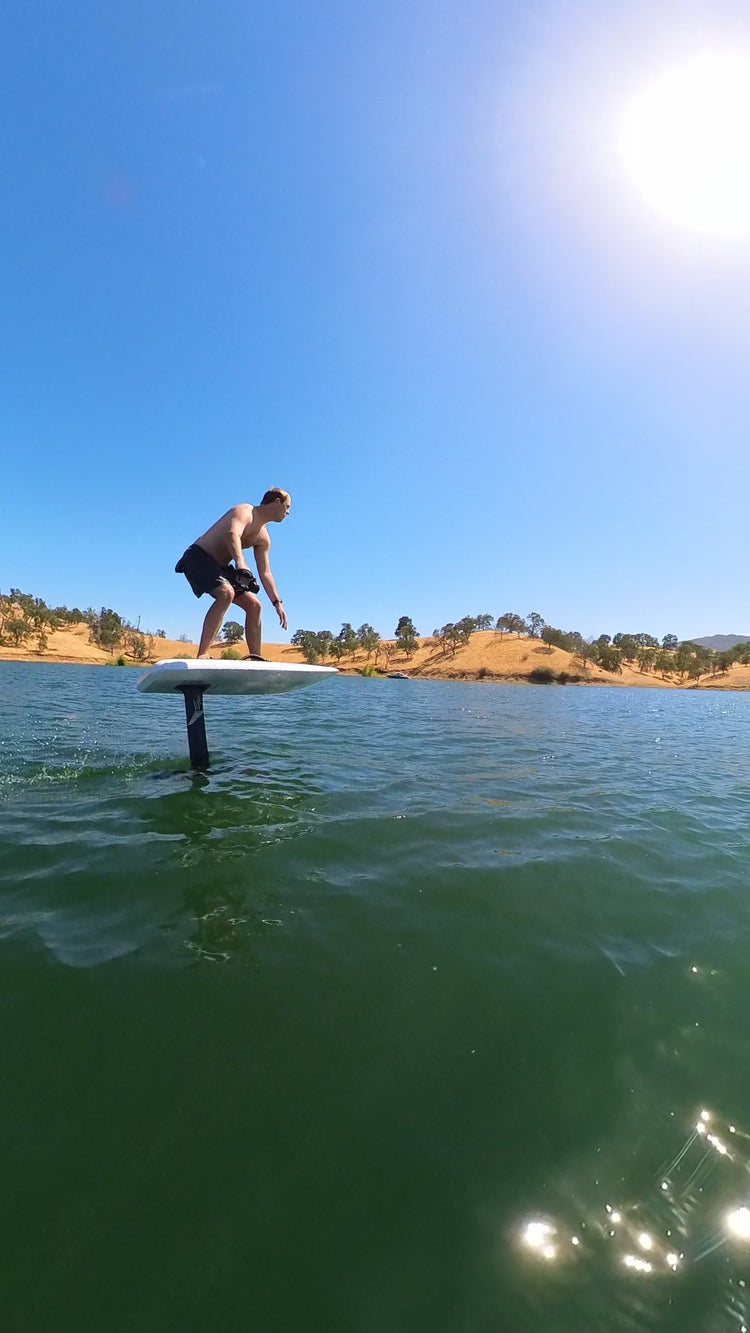

Congratulations on your new stand up paddleboard! We have put together a list of best practices that will help you store, maintain, and enjoy your new board for years to come.
This however is a living breathing document so please do send us any ideas on things to add or change to make it useful for all stand up paddlers. Send any and all input to info@101surfsports.com
Storing Your Board
- The Sun is your enemy. More precisely the sun’s Ultra Violet (UV) rays. Carbon Fiber boards, particularly ones that are not painted completely, are more at risk. UV expedites the aging process. Covering your board will protect it from UV but caution must be used to ensure you are not making the board too hot.
- Leaving your board in the sun all day on the beach should be avoided if the board is not in use. This is especially true for inflatables. If your board has a removable vent plug, and you must leave it in the sun for an extended period of time, then consider removing the plug. Make sure to re-insert the plug before putting the board back in the water. Note Gore-Tex self-regulating vent plugs should almost never be messed with.
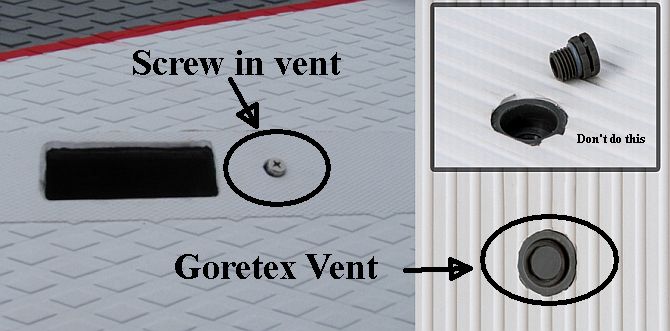
- Impact is your enemy. Even the best made boards can be dinged. Quite often damage is caused not by use, but by a less than ideal storage situation. Car doors and falling bikes account for many dings. Using board bags and purpose built storage racks is a good idea.
- Board Bags. We recommend most boards be bagged. Particularly boards that spend a great deal of time on the car top. The weak link of a low cost board bag is cheap zippers. Sadly a broken zipper is expensive to fix and somewhat ruins the bag if not working. Things to consider in a board bag
- Thickness of foam inside the bag
- 2-3mm = Day bag
- 3-6mm = Tough bag
- 6-10mm = Travel Bag
- Thickness of foam inside the bag
-
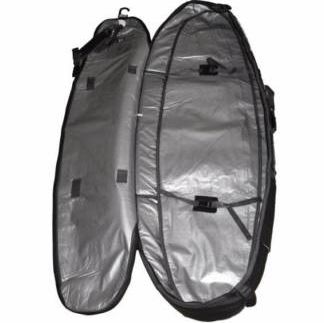 Coffin style board bags (pictured at right) are the easiest bags to place a board in to. Coffin means the zipper runs the entire perimeter of the bag allowing the board to be placed in the bag from the top rather than inserted from the end. They are usually a bit more expensive due to the bigger zipper.
Coffin style board bags (pictured at right) are the easiest bags to place a board in to. Coffin means the zipper runs the entire perimeter of the bag allowing the board to be placed in the bag from the top rather than inserted from the end. They are usually a bit more expensive due to the bigger zipper. - Board Socks or covers are great for UV protection and offer a lightweight easy to use solution. The ding protection however is not as good as day bags.
- Vented board bags are better than non-vented board bags when the bags will be exposed to high heat environments.
- Gusseted bags allow for a tighter fit minimizing wind noise while driving. Gussets are straps on the bags side that allow a more custom fit.
- Keep your zippers well rinsed with fresh water to stop salt build up/frozen zippers.
- Fresh water can cause mold and mildew so make sure to dry out your gear before storing when fresh water is in the mix.
- The best bag in the world will not guarantee a safe airplane flight.
- Never put a wet board into a board bag and then allow direct sunlight on the bag. This can ruin the paint on the board.
- We recommend rail taping all boards. This helps when setting the board down on its rail.
Car topping
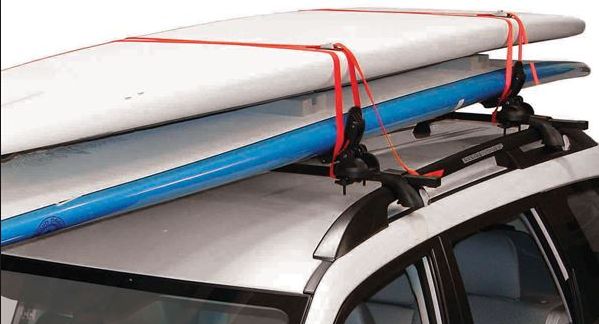
- We recommend that boards are placed nose forward fin up position for most boards.
- Option 2 is with the fin forward and the deck facing up.
- SAFETY NOTE - Long boards or long drives. You should strongly consider a line from the front of the car attached to the leash plug on the board. This insures the board will not fly off the car in the event the rack fails.
- Double check your racks attachment to the car. Having a professional, like the guys at Rack and Road in San Rafael install your rack is a good call.
- Racks should always be padded even when using a board bags.
- Cam Straps should always go around the rack bars and not the rails or feet of the racks. The straps should come down near the board’s sides with as little gap as possible.(see photo above)
- Cam Strap buckles should be placed, and kept near the middle of the board. They should never be near the rail. The photo above is as close to the edge as they should ever get. Pulling on a cam strap buckle located on the rail of the board can result in damage. In the photo at top they are OK but we'd prefer to see them in the middle.
- Trick – Intentionally put one or two twists in the strap that does not have the cam buckle. This will help stop it vibrating like a guitar string when driving.
- SAFETY NOTE - Cam Straps should be proactively replaced as they age or wear.
- Never place a board on top of a car without immediate plans to get a strap on it. We have proven driving away with a board that is not strapped down is bad.
- Be mindful of wind when loading a board on the car. They are light and can easily blow off the top.
- Do not over tension the cam strap. This is not a lumber run from Home Depot. Over tightening your strap can damage your board. The boards should be firmly strapped but do not crank on the strap too hard.
- Stacking boards should be done with strong foam separation between the two boards. Stacking two boards without this is going to damage one. This is particularly true for displacement hull stand up paddleboards.
- Be aware of your new height profile. With your board on your roof and the fin pointed up you may not make it under that overhang in your life. Driving in to your garage with the board on the roof can be unpleasant at best.
- Be aware when strapping down your board it’s the people behind you at the greatest risk. All you lose is a board but it could seriously hurt a following motorist.
- If possible you should consider adding a line that attaches the nose of the board to the front of the car.
- Strongly consider the Yakima SUP Dawg (pictured below). We find it to be the best SUP carrier on the market.
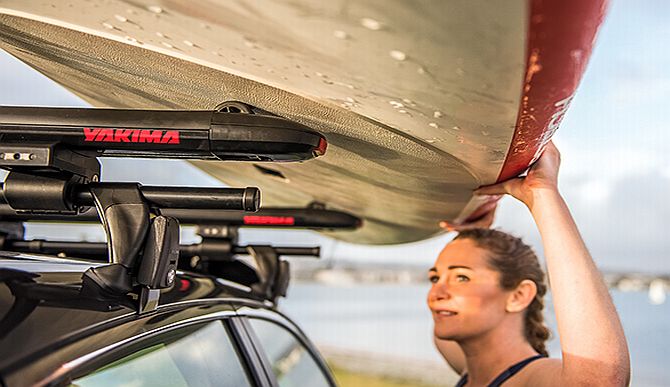
Using Your Board
- Vent Plugs can be found on many boards. See photos above.
- Gore-Tex - If your board has a self-regulated vent plug you should not mess with it. Bubbles coming out of the vent are normal and a sign the board is equalizing its internal pressure
- Removable Vent Plugs – Remove these plugs when sending boards to altitude like Tahoe or for airplane travel.
- It’s a good idea – but not totally necessary – to fresh water rinse a board after use. If you use a board bag you should try to avoid putting salty boards in the bag. Never put a wet board in a board bag and then allow direct sunlight to hit it. This can ruin the boards paint.
- Deck Pads. Try to avoid scraping the deck pad. Keeping the deck pad from getting too hot is a good idea. Deck pads can bubble when exposed to high heat over a long period of time.
- Waxing a board with a Turtle wax, or a similar wax, once a year is not a bad idea.
- Traveling with boards requires extra attention to packing. Airlines are notorious for damaging boards. Be sure you know all your airlines restrictions before you get to the airport. Write down the names & phone numbers of people you talk to that promise you anything with respect to these restrictions.
- We recommend rail taping all boards. This helps when setting the board down on its rail. We further recommend you do not apply this yourself. It’s a skill that requires practice and a bad application can potentially strip your board of paint or decals or both.
- Be careful when setting your paddleboard on the ground. Sharp objects can pierce the hull. Rail tape helps a lot for those temporary rests on the rail.
- Always write your name and phone number on all your watersports gear. This is an important point of safety. The US Coast Guard implores us to do this to prevent unneeded searching when lost gear is found floating around.
- Always write your name & phone # on your paddle. Many look alike and are often left behind.
- If you have a surfing style SUP, where the deck pad is not full length, consider adding traction spray to the nose. It will increase the amount of board you can use to aid in catching waves.
Safety
- This is a small section for a big issue. Please read our complete water safety section on our website.
- File a float plan. This means let someone know where you are going and when you’ll be back.
- Try to paddle with a buddy.
- Take a communication device with you. As in radio or cell phone.
- Always wear the right gear for the day. click here for more info on what to wear stand up paddleboarding.
- Know you weather. Always know the weather forecast for your specific paddling area. Always stay alert for changes despite whatever that forecast told you.
- Know your tides
- Always Wear Leash on your board. This is an ALWAYS not a sometimes. Make sure your leash is well connected to your board and yourself.
- Always have a Lifejacket with you. The surf zone may be the one exception
- You are a mariner now. Perhaps taking some seamanship classes is a good idea? Do you know what “Red, Right, Return” means. You should.
- Keep a high state of 306 degree situational awareness at all times. Be aware of your surroundings and make safety your first priority. Things can come up from behind you.
- Boats and basically everything else on the water has the right of way over a paddleboarder. Stay clear.
- Label your gear with your name and contact information.
- When in doubt don’t go out.
- More complete safety section click here
Dinged Paddleboard?
- Scratches – Scratches are just cosmetic and do not materially affect performance. Some tricks for dealing with scratches;
- Light Scratch – Try rubbing it with a wet Mr. Clean Magic Eraser. Make sure the eraser stays wet and do not over rub the area. Do not use
- Deep Scratch – Consider a enamel nail polish to color match and seal
- Stains or discolorations - First try rubbing compound applied very carefully in a small test area. If that does not work try 1000 wet dry sand paper. WARNING – over sanding or over use of rubbing compound can remove the clear coat or paint layers on your board making a scratch a bigger cosmetic issue than it was to start.
- Pressure Dents – The general rule of thumb is never break the skin of your board as long as it’s sealed. This means 9 time out of 10 you should do nothing to a pressure dent. Pressure dents (pictured below) usually do not materially affect performance.
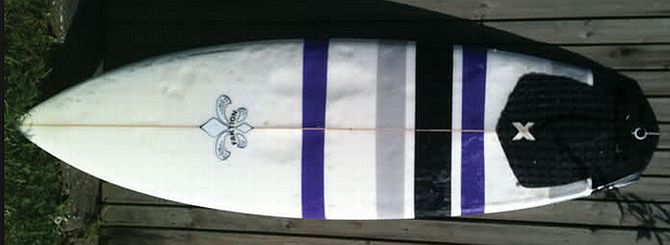
- You got a Ding? A ding is by definition a breach of the boards outer skin.
- The key to all dings is to keep water out of the core of the board. Do not go in the water without first sealing the wound. Temporary Fixes that keep you riding include
- Puka Patches (You should never be without these)
- Dingle Berries / Two Part Epoxy Putty (this should always come with you on any trip)
- The key to all dings is to keep water out of the core of the board. Do not go in the water without first sealing the wound. Temporary Fixes that keep you riding include
- Repairs usually take 3-4 weeks and cost from $75-$200
- No board should be sealed until the core is dry as possible. It’s important that if water is in your board core that you dry it as much as possible. Sealing the board with water in it and then exposing it to sun/heat can result in delamination – see below.
- Delamination – Delamination is when the skin of the board detaches from the core. Many times the board is still water tight. It is normally not worth repairing delaminated boards. It’s a like a short tailed dog chasing its tail. Futile, costly, and can expedite the end of the board. We suggest you keep riding it until it dies. Note that delaminated boards are more likely to break as there structure has been violated.
- Fins are a very important part of your board’s performance. They can however be dangerous so always be weary of their sharp edges and pointy tops and bases.
- Do not stand your board on your fin. This can bend the fin – particularly a fiberglass fin that has been in the sun.
- Lay your board deck down when leaving it on the ground with the fin pointed up or on its side. Make sure to place something on the fin (foam block or cover) to protect anyone from falling on the fin.

